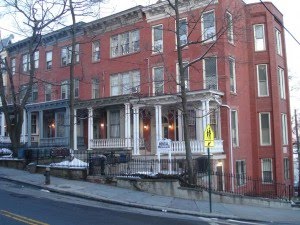Staten Island Lighthouse
Posted by Tom Crimmins Realty, Ltd. on
Right in the heart of Staten Island, just minutes away from the Staten Island Mall, lies Lighthouse Hill, a quaint neighborhood full of greenery and large, open houses. Lighthouse Hill lies right between a large array of parks and is only minutes away from both the mall and historic Richmond Town, giving residents a way to experience any range of environments. The hill's name comes from Staten Island Range Lighthouse, also called the Ambrose Channel Range Light, or affectionately called the Staten Island Light. The lighthouse is the rear range lighthouse companion to the West Bank Lighthouse.
About the lighthouse
A 90-foot tower built in 1912, it sits about 5 miles northwest of its companion, 141 feet above sea level on Lighthouse Hill (also called…
1077 Views, 0 Comments



 This historic home is one among the row of houses along Westervelt Avenue designated, Horton's Row. The row of houses was constructed between 1880 and 1882 by Harry Horton, a prominent New York City banker and broker. It consisted of twelve identical attached masonry row houses, which were built as an affordable option for middle-class families on Staten Island. However, out of the twelve, 413 Westervelt is one of the four that remained intact.
This historic home is one among the row of houses along Westervelt Avenue designated, Horton's Row. The row of houses was constructed between 1880 and 1882 by Harry Horton, a prominent New York City banker and broker. It consisted of twelve identical attached masonry row houses, which were built as an affordable option for middle-class families on Staten Island. However, out of the twelve, 413 Westervelt is one of the four that remained intact.
 The Britton Cottage is located at the foot of Court Place. It was originally located in New Dorp Beach but was moved to Historic Richmond Town in 1965. This is a one and a half story wood-framed house that was built around the 1670's. Additions to the house were made to the house later on. The house was first conveyed to Obadiah Holmes in 1677, Holmes was a clerk. It was believed that the house was used as a public building as well as a residential living area. In 1695 the cottage was conveyed to Nathaniel and Elizabeth Britton, they helped establish the English Presbyterian Church in Staten Island,1729. They lived in the cottage until 1714. Thomas Walton then resided in the cottage and few more people after. Eventually it was inherited by Harriet Lord…
The Britton Cottage is located at the foot of Court Place. It was originally located in New Dorp Beach but was moved to Historic Richmond Town in 1965. This is a one and a half story wood-framed house that was built around the 1670's. Additions to the house were made to the house later on. The house was first conveyed to Obadiah Holmes in 1677, Holmes was a clerk. It was believed that the house was used as a public building as well as a residential living area. In 1695 the cottage was conveyed to Nathaniel and Elizabeth Britton, they helped establish the English Presbyterian Church in Staten Island,1729. They lived in the cottage until 1714. Thomas Walton then resided in the cottage and few more people after. Eventually it was inherited by Harriet Lord…